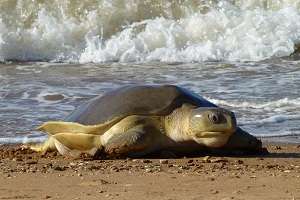Threatened flatback sea turtle (Natator depressus) returning to nest in the Pilbara

Populations of the threatened flatback sea turtle (Natator depressus) are returning in droves to nest on beaches in the Pilbara, with their behaviour being chronicled by local volunteers.
Environmental group Care for Hedland is in the 10th season of its turtle monitoring program with a current focus on collecting data for use in population-based studies.
The monitoring program at Cemetery Beach and Pretty Pool in Port Hedland operates from October to March in correlation with the annual flatback migration to the coastline for the nesting and hatchling seasons.
Care for Hedland scientific coordinator Linda Reinhold says on a peak night they had 10-20 individual turtles on the beach with some crawling up the beach a couple of times before actually laying eggs.
She says so far 187 individual turtles had been recorded coming onto the beach, including 30 new to the rookery, compared to 197 individual turtles for the previous season.
"The female will lay a clutch of eggs, which consists of 50 eggs, and about 11 days later she will come back and dig another hole and lay more eggs," she says.
"She can only produce 50 at a time so she will lay them when she has manufactured them; she has to release the sperm and the vitellogenic follicle and they go down the duct and get shelled, so it takes her about 11 days for the next batch of eggs to be ready to lay.
"We have had some turtles that have laid their fourth clutch for the season already but on average they might only lay three clutches for the season, so I guess if you have got 200 turtles laying 150 eggs each [there might be] 25,000 turtles for the season."
The program involves collecting data through beach patrols to assess turtle tracks and sand patterns and record the location of laid and hatched nest locations while also documenting predator activity.
Ms Reinhold says after 42 nights they had attached 200 flipper tags and about 30 microchip tags on brand new turtles.
"The actual tagging is of the nesting females, so no hatchling tagging here, but it would be a great idea for next season to do the age experiment," she says.
"We know from Queensland [research] that their flatbacks come back to nest at 21 years of age and have a survival rate of about one in 2,000 but I reckon that Cemetery Beach would be the perfect place to do it in WA."
Provided by Science Network WA


















